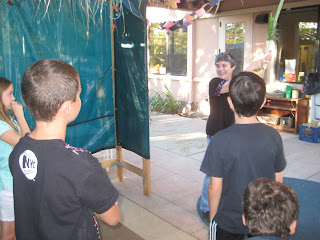Now it's time to look around ourselves and appreciate God's universe in a more joyous fashion. Last night, the first of three major harvest festivals began - Sukkot. It's the harvest of the first fruits and a time to look forward to the start of the rainy season both in Israel and in our own California.
I introduced the holiday to the students by asking them to define what a "symbol" is and to name important Jewish symbols. We reviewed what we had learned about the major symbol for Rosh Ha'shana - the shofar (see 9/18 post). We then began to discuss Sukkot and its two major symbols - the lulav (a bundle made of a palm, willow and myrtle branch tied together) and etrog (a citron), and the sukkah (a 3-walled hut with a roof made of branches through which we are able to view the stars in the sky at night).
 |
| Showing the students the three types of branches making up the lulav |
 |
| Discussing the date of the holiday - the 15th day of the month of Tishrei |
 |
| We visited the Sukkah built by the Bonim students and their parents this past Sunday, and continued our lesson about the symbols of Sukkot there. |
So why did God command the Israelites to build sukkot with only 3 walls and a fairly open roof? A few students realized that it would build faith in the Israelites for a God they couldn't see or hear, but knew only through Moses, their leader. God would protect them from flash floods and other dangers. Thus, the sukkah becomes a symbol of faith in God, even as it's reminding our people of our earliest history as a nation. It's also a reminder of when we finally settled in the Land of Canaan, where many of us became farmers and harvested fruits and grains in their seasons. During the seven days of the harvest, the farmers slept and protected themselves from the harsh sun in sukkot. Here, the sukkah reminds us of a time when we were farmers in our own land. When we are commanded to live in the sukkah for seven days, it is to remind us about what life was like when we were farmers and dependent upon God's nature for our survival.
Another Rabbi taught that each part of the lulav and etrog symbol represented a geographic area in the Land of Israel, reminding us where we came from and that we would return there once again.
A third Rabbi taught that each part of the lulav and etrog symbol represented a different type of Jew: one who studied Torah but didn't do good deeds; one who did good deeds but didn't study Torah; one who did neither and one who did both. Thus, by shaking the lulav holding all the parts together, we are united as one nation, praising God together.
Different Edot (Jewish Diaspora communities) developed their own customs for following the commandments of living in the sukkah and shaking the lulav and etrog, but these rituals were an annual reminder of who we were, where we came from, and of our role as partners to God in tikkun olam - repairing the world.
As we go through the Jewish holiday calendar during the school year, I'll be sharing other symbols and the rituals associated with these symbols that the Rabbis devised relating to each holiday, all designed to keeping a dispersed nation together by reinforcing a memory of a common history and purpose.
This week, we ended each session with learning songs taught by our new music director, Ben.
 |
| Y'tzira and Shira students joined us in our Edot classroom... |
 |
| ...which filled up very quickly! |
Then Ben, at my request, taught us a song that many of the students already knew from previous years, but which I wanted to be sure all my Edot students would know - "Am Yisrael Chai." He taught us a version sung in Africa, and I wanted to be sure all my students knew it since we'll be singing it during an Ethiopian Jewish Sigd Festival we'll be re-enacting on Sunday, November 12th on our Isaiah campus. Much more information to come about this event in a few weeks!
I'm looking forward to seeing you all this coming Sunday, when we will have a regular session, but then enjoy a special concert by Rick Recht, from 10:30 to 11:30 a.m. (half an hour longer than when our tefillah session usually ends, at 11:00). I hope everyone can stay for the full concert!
And for those students who are participating in the Stumper/Challenge program, I hung up 2 new Sukkot stumpers and 1 Simchat Torah stumper, as well as two worksheets - one for Sukkot and one for Simchat Torah.
 | |||||||||
Stumpers:
1.) Which American holiday, founded in 1621, is based on Sukkot?
2.) Who is the "Hatan Torah?" Who is the "Hatan Berayshit?"
3.) What is another name for Sukkot in the Bible?
CHAG SUKKOT SAME'ACH!
HAPPY SUKKOT HOLIDAY!



No comments:
Post a Comment